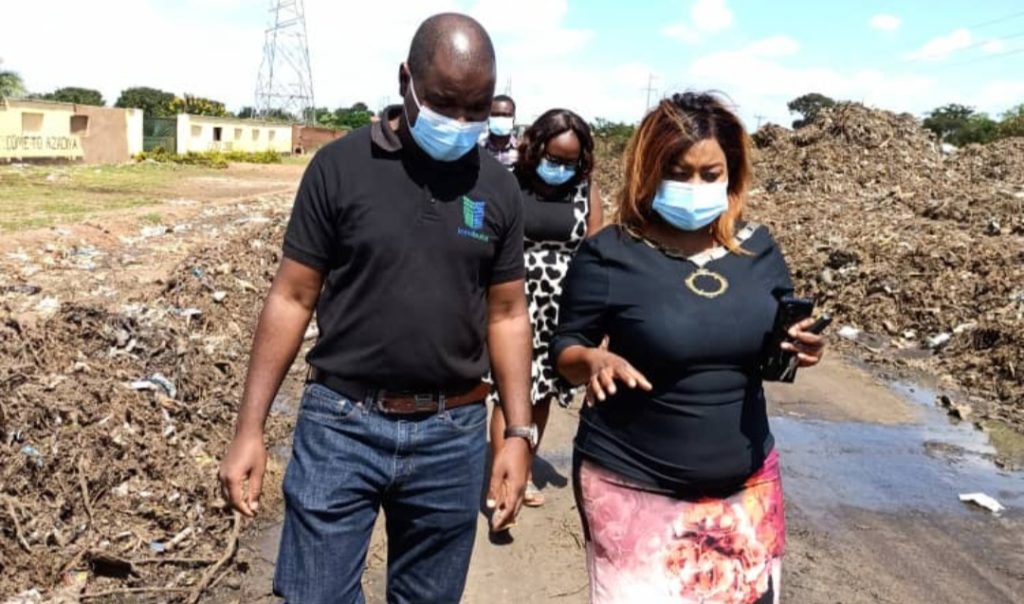Lawlessness, obscenity and rottenness.
That sums up what the largest waste dumping site neighbourhood in Lilongwe has become. The landfill is what no one cherishes to have as a neighbour.
Waste from Area 38 dumpsite spilling on the road
But there it is; sitting heavy on several hectares of prime land in Area 38 and subjecting hundreds of residents to some hell. Of course, long before the biblically professed judgement day spews its agony on the sinners.
The atmosphere here is dense, polluted by incessant odour. Oxygen is acutely low, making breathing—a generally simple task—a literally choking game.
Little wonder, those passing by, yield faces that are thickly wrinkled with uneasiness. They are frequently seen shielding their nostrils with handkerchiefs or whatever is conveniently helpful.
It is also tellingly difficult to be a saint here. The dumping place’s proverbial natives, the dirt-soaked human scavengers fire—without any care—vile abuses at innocent passers-by as they smartly sift through heaps of rubbish.
The distress does not stop there.
Driving through the road that connects Area 23 to the neighbouring townships to the M1, is an almost impossible mission.
The section that passes near the dumpsite has, times without number, been impassable due to mountains of garbage gathering up on the edges; spilling all manner of trash onto the road.
Banned thin plastic papers and diapers have all found their way onto the heaps of garbage on the tarred surface, so have worn out equipment. Torn clothes and shoes are pieces of the smelly puzzle too; reducing the two-way lane into a stinky narrow path.
Yet, it was never supposed to be like this.
“What happens is that the road that diverts to the real dumpsite, which is some distance away from here, is impassable during rainy season.
“As a result, trucks end up dumping the waste on the roadside,” explains Jack Manong’a, who lives nearby.
Just like other residents, he is paying a price for this lawlessness, a painful one for that matter. He testifies that when the dumping booms, he is forced to park his vehicle at home and walk to work.
“We no longer want this dumpsite here. Government should get rid of it,” Manong’a cries out loud.
For now, his tears can afford to dry. Things are getting better. Innobuild Limited Company, one of the country’s real estate firms, has embarked on a mission to bring sanity.
The company has, as a corporate social responsibility, been clearing the trash from the road and effectively the odour, easing the breathing among passers-by and residents.
“This huge pile of trash is not years old. It is just months old. It’s increasing day by day,” observes Innobuild chief executive officer Billy Chiotha.
He adds: “This can be managed if all of us understand that we have got a responsibility to ensure that those who are staying here are not paying for our sins.”
Chiotha, his face getting bolder, points out that his firm’s corporate social responsibility commitments may vanish sooner or later. He, therefore, appeals to the Lilongwe City Council (LCC) to muscle up against the waste.
“We appeal to the council to concretise the road that diverts to the dumpsite. The moment that is done, we won’t be seeing this. And, they can ably enforce the by-laws of this dumpsite which makes it illegal to dump trash on the road,” he guides.
Lilongwe deputy mayor Esther Sagawa admits that the dump site’s rottenness can erupt into disease outbreaks that can take out lives with relative ease.
In the wake of the prevalent worst cholera outbreak that has killed 1 760 and infected 58 700, the deputy mayor’s acknowledgement is closer to the truth than anything.
However, those in charge at the council and herself hold the key to ending the chaos here.
And, for once, LCC seems to be taking steps, though seemingly short and slow.
“In addition to the access road challenges, the trash that piles up on the road is dumped at night when those that supervise aren’t around. As a council we try our best to ensure this place is smart.
“And, we are doing our best to ensure that the careless dumping should not be repeated. The council has hired machinery to clear up the road that leads to the real dumpsite so that dumping should not be done on the road side,” Sagawa affirms.
The dumping site rottenness has also been a source of fury for the Parliamentary Committee on Natural Resources and Climate Change which earlier this year ordered LCC and Malawi Environmental Protection Authority to close it.
The committee chairperson Werani Chilenga, during his team’s visit to the site, called it what it really is: a health hazard.
The committee gave the two institutions two weeks to relocate the landfill. It has been three months now but the dump lives on and stinks on.
Asked why they have not taken the order; the deputy mayor said the council does not have funds to take the stench somewhere away from the people.
“We need K14 billion to relocate the dumping site,” Sagawa pronounces.
That will, unquestionably, turn out to be the costliest migration of trash and stench.
The post Enduring dump-site rottenness first appeared on The Nation Online.
 Moni Malawi
Moni Malawi 

